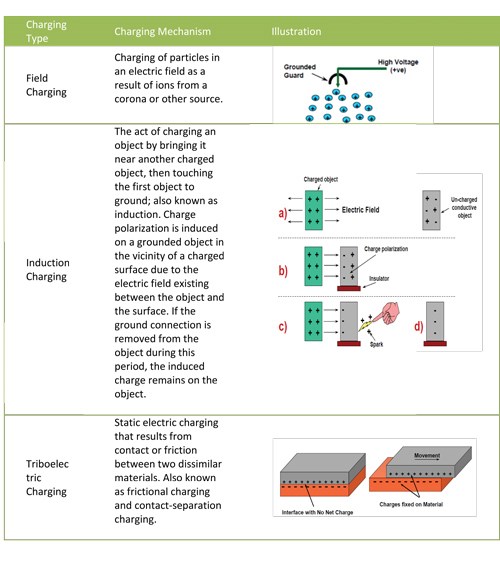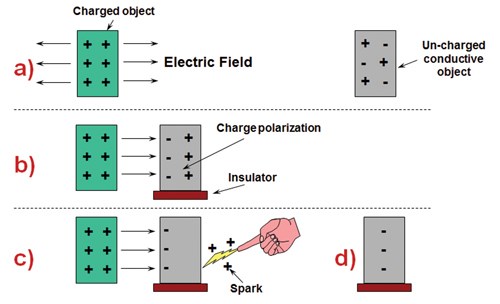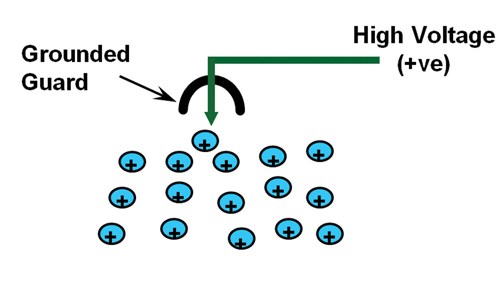Dis-Charge Your Powder
A practical approach to managing electrostatic problems and hazards during powder coating
Generating electrostatic charge during powder coating is almost inevitable, owing to the surface contact, separation and movement during these operations. In addition, if the powders are not good conductors of electricity, and most are not, electrostatic charges will accumulate on them, the processing equipment, isolated metal components, and other surfaces and equipment. However, the generated charge is not generally hazardous unless it is allowed to accumulate, at which point it is capable of igniting flammable gas, vapor and dust cloud atmospheres.
In an industrial setting, electrostatic charge can accumulate on:
Non-conductive (insulating) materials and items, such as plastic pipes and hoses, liners and containers.
Non-conductive bulk solids and powders.
Metal equipment that is isolated from electrical ground, such as metal piping, ductwork, chutes, vessels and containers.
Personnel isolated from ground by wearing insulating footwear and/or standing on insulating flooring.
Understanding the nature of electrostatic charge generation and retention is the first step in controlling the static electricity.
Charge Generation
It is not always trivial to predict the polarity and magnitude of charge generation during powder handling and processing operations. Charging of objects could be due to any one of the mechanisms presented in Table 1.
It is important to note that the chemical composition of the involved materials, charging mechanism and surrounding environmental conditions most often influence the magnitude and polarity of electrostatic charging.
On Insulating Solids: The ability of powder materials to retain static charge even if the powder is in contact with an electrically grounded conductive surface is known as volume resistivity. Generally, powders are divided into three groups:
Powders with volume resistivity up to about 106W•m are considered conductive.
Powders with volume resistivity in the range 106W•m to 109W•m are medium resistivity or semi-conductive.
Powders with resistivity above 109 W•m are high resistivity or insulating powders.
The higher the resistivity, the higher the probability of retaining electrostatic charge when handled in grounded conductive containers.
On Insulating Powder Handling Objects: Electrostatic charge could also accumulate on insulating powder handling equipment such as plastic containers, liners, plastic pipes and hoses. The propensity of a solid material to accumulate static charge is reflected in its volume and surface resistivity. Materials having a volume resistivity of 109 ohm-meters (W•m) or greater and a surface resistivity of 1x1011 ohms per square or greater are generally considered insulating (high resistivity) in electrostatic terms and are prone to charge accumulation.
On Isolated Conductors: Static charge can accumulate on conductors (metal piping, flanges, vessels, tools, decking and other metal items) isolated from electrical ground with a resistance-to-ground exceeding 1x106 Ω.
On the Human Body: The human body is an electrical conductor. Charge accumulated on personnel can give rise to discharges upon exposure to conductors at a lower potential (e.g., ground). Such discharges can be sufficiently energetic to ignite flammable atmospheres with a minimum ignition energy (MIE) less than about 30 milli Joules (mJ).
Electrostatic Discharges
The accumulation and retention of charge on various objects could lead to a potential release of stored energy in the form of an electrostatic discharge. There are several types of electrostatic discharges that may occur during powder handling/processing operations:
Spark discharges
Brush discharges
Cone (bulking) discharges
Propagating brush discharges
A description of these discharges and their respective energies is provided in Table 2.
Many of these electrostatic discharges can be controlled to ensure that they do not become a potential ignition source. Suggestions for controlling electrostatic ignition hazards associated with specific equipment and operations are discussed in Table 3.
Controlling Electrostatic Ignition Hazards
To effectively control electrostatic hazards associated with powders, the following information would be required:
Sensitivity of the powder to ignition by electrostatic discharges (minimum ignition energy) (measured according to ASTM E 2019, Standard Test Method for Minimum Ignition Energy of a Dust Cloud in Air). The MIE test determines the lowest spark energy that is capable of igniting a dust cloud at its optimum ignitable concentration. This test is used primarily to assess the susceptibility of dust clouds to ignition by low-energy sources such as electrostatic sparks.
Conductivity (volume resistivity) of the powder (measured according to ASTM D 257, Standard Test Methods for DC Resistance or Conductance of Insulating Materials). This test measures the electrical resistance of a powder layer. Volume resistivity classifies powders as low, moderately or highly insulating. Insulating powders have a propensity to retain static charge and can lead to hazardous electrostatic discharges when exposed to grounded facilities, equipment or personnel.
Electrostatic charging rate (chargeability) of the powder (measured in general accordance with ASTM D 257, Standard Test Methods for DC Resistance or Conductance of Insulating Materials). Electrostatic chargeability is a measure of the propensity of powder particles to become charged when flowing through conveyances or when handled in containers. This test provides data that can be used to develop appropriate materials-handling guidelines from an electrostatic hazards point of view.
Information regarding the material of construction of the powder processing/handling equipment (metal or plastic) and equipment design and operation. Table 3 provides some general guideline measures for controlling electrostatic discharges.
Additional Guidelines
The guidelines above are general in nature, and additional and/or different precautions may be needed for particular applications. It is highly recommended that coaters seek expert advice to evaluate electrostatic hazard situations and determine the practical method to control it.
Although grounding of conductive items does not necessarily eliminate all potential electrostatic ignition hazards and processing problems, it goes a long way towards achieving this goal.
Plastic pipes and hoses, plastic hoses with metal reinforcing wires (even if the reinforcing wire is electrically grounded), plastic hoses with metal sheaths, and plastic-lined metal pipes should not be used for the pneumatic conveying of explosible powders. This is because pneumatic conveying of powders could result in the development of high levels of electrostatic charge on the inside surfaces of plastic hoses and pipes and can cause propagating brush discharges.
Plastic containers or plastic liners and bags should not be used for receiving highly charged powders unless the breakdown voltage across the plastic container or liner is less than 4kV. This is because materials that have a breakdown voltage less than 4kV are not capable of giving rise to “propagating brush discharges.”
Grounding of personnel is most practically accomplished through the combination of antistatic footwear and antistatic or conductive flooring for operating areas.
High relative humidity can reduce the resistivity of some surfaces and powders and thus increase the rate of charge decay from such materials in contact with grounded metal. However, in most cases this will only be effective if a relative humidity in excess of 65 percent is maintained.
Electrostatic charge neutralization (elimination) is one method for eliminating the accumulated electrostatic charge on insulating surfaces and powders. Special care should be taken to ensure that an electrostatic charge-neutralization device would not become an ignition source of a dust cloud explosion.
Muhammad Qureshi, Ph.D., is a process safety specialist at Chilworth Global. Please contact him at 609-799-4449 or at safety@chilworth.com.
Related Content
Calculating the Cost of Powder Coating
How can you calculate the cost of powder coating a component if you only know its surface area? Powder coating expert Rodger Talbert has the answer.
Read MoreMasking Solutions Provider CFS Dramatically Expands Capabilities and Capacity
Custom Fabrication & Supplies (CFS) completed a new plant expansion packing 10 times the capacity into twice the space. It dramatically enhances the supplier’s custom capabilities to provide extremely precise and cost-effective masking solutions.
Read MorePowder Coating 4.0: Smarter, Faster, More Efficient and Connected
New tools reduce cost and waste, lower manufacturing footprint of powder coating operations.
Read MoreAdjusting Current and Voltage When Powder Coating
Which manual powder coating gun setting is better to adjust, voltage or current? Jeff Hale of Gema USA discusses when to use different settings on your powder gun to achieve optimal results.
Read MoreRead Next
Delivering Increased Benefits to Greenhouse Films
Baystar's Borstar technology is helping customers deliver better, more reliable production methods to greenhouse agriculture.
Read MoreA ‘Clean’ Agenda Offers Unique Presentations in Chicago
The 2024 Parts Cleaning Conference, co-located with the International Manufacturing Technology Show, includes presentations by several speakers who are new to the conference and topics that have not been covered in past editions of this event.
Read MoreEducation Bringing Cleaning to Machining
Debuting new speakers and cleaning technology content during this half-day workshop co-located with IMTS 2024.
Read More

























